Potential of X-Band Images from High-Resolution Satellite SAR Sensors to Assess Growth and Yield in Paddy Rice
Abstract
:1. Introduction
2. Materials and Methods
2.1. Study Site
2.2. Acquisition and Processing of CSK and TSX SAR Images
2.3. Ground-Based Data Acquisition
2.3.1. Biophysical Measurements of Rice Canopies
2.3.2. Determination of Transplanting Date in Individual Rice Paddies
2.4. Analytical Approaches
2.4.1. Extraction of σ0 Values from SAR Images and their Statistical Analysis
2.4.2. A Simple Canopy Backscattering Model in Support of Experimental Analysis
3. Results and Discussion
3.1. Difference and Consistency of σ0 Values from CSK and TSX
3.1.1. Response of σ0 to Transplanting and Water Surfaces
3.1.2. Intercomparison of σ0 from CSK and TSX
3.2. Relationships between the X-Band σ0 and Canopy Biophysical Variables
3.2.1. Analysis Using the Datasets for CSK and TSX
3.2.2. Analysis Using the Combined CSK and TSX Dataset
3.2.3. Examination of the Close Relationship of σ0 with Panicle Biomass
3.2.4. Analysis Using a Simple Canopy Scattering Model
3.3. Overall Capability of X-Band σ0 and its Improvement for the Assessment of Biophysical Variables
4. Conclusions
Acknowledgments
Author Contributions
Conflicts of Interest
References
- Moran, M.S.; Inoue, Y.; Barnes, E.M. Opportunities and limitations for image-based remote sensing in precision crop management. Remote Sens. Environ 1997, 61, 319–346. [Google Scholar]
- Inoue, Y. Synergy of remote sensing and modeling for estimating ecophysiological processes in plant production. Plant Prod. Sci 2003, 6, 3–16. [Google Scholar]
- Doraiswamy, P.C.; Hatfield, J.L.; Jackson, T.J.; Akhmedov, B.; Prueger, J.; Stern, A. Crop condition and yield simulation using Landsat and MODIS. Remote Sens. Environ 2004, 92, 548–559. [Google Scholar]
- Becker-Reshef, I.; Justice, C.; Sullivan, M.; Vermote, E.; Tucker, C.; Anyamba, A.; Small, J.; Pak, E.; Masuoka, E.; Schmaltz, J.; et al. Monitoring global croplands with coarse resolution earth observations: The Global Agriculture Monitoring (GLAM) Project. Remote Sens 2010, 2, 1589–1609. [Google Scholar]
- Ishijima, K.; Sugawara, S.; Kawamura, K.; Hashida, G.; Morimoto, S.; Murayama, S.; Aoki, S.; Nakazawa, T. Temporal variations of the atmospheric nitrous oxide concentration and its δ15N and δ18O for the latter half of the 20th century reconstructed from firn air analyses. J. Geophys. Res 2007, 112, D03305. [Google Scholar]
- Nishio, M. Agriculture and Environmental Pollution—Technology and Policy for Soil Environment; Rural culture Association: Tokyo, Japan, 2005; p. 439. [Google Scholar]
- Inoue, Y.; Dabrowska-Zierinska, K.; Qi, J. Synoptic assessment of environmental impact of agricultural management: A case study on nitrogen fertilizer impact on groundwater quality, using a fine-scale geoinformation system. Int. J. Environ. Stud 2012, 69, 443–460. [Google Scholar]
- Le Toan, T.; Ribbes, F.; Wang, L.F.; Nicolas, F.; Ding, K.H.; Kong, J.A.; Fujita, M.; Kurosu, T. Rice crop mapping and monitoring using ERS-1 data based on experiment and modeling results. IEEE Trans. Geosci. Remote Sens 1997, 35, 41–56. [Google Scholar]
- Brisco, B.; Brown, R.J. Agricultural Applications with Radar. In Manual of Remote Sensing Principles and Applications Imaging Radar, 3rd ed; Henderson, F., Lewis, A., Eds.; Wiley: New York, NY, USA, 1998; pp. 381–406. [Google Scholar]
- Jackson, T.J. Remote Sensing Soil Moisture. In Encyclopedia of Soils in the Environment; Hillel, D., Ed.; Elsevier Ltd.: Oxford, UK, 2005; pp. 392–398. [Google Scholar]
- Lopez-Sanchez, J.M.; Ballester-Berman, J.D. Potentials of polarimetric SAR interferometry for agriculture monitoring. Radio Sci 2009, 44. [Google Scholar] [CrossRef]
- Inoue, Y.; Sakaiya, E. Relationship between X-band backscattering coefficients from high-resolution satellite SAR and biophysical variables in paddy rice. Remote Sens. Lett 2013, 4, 288–295. [Google Scholar]
- Inoue, Y.; Sakaiya, E.; Wang, C. Capability of C-band backscattering coefficients from high-resolution satellite SAR sensors to assess biophysical variables in paddy rice. Remote Sens. Environ 2014, 140, 257–266. [Google Scholar]
- Baldini, L.; Roberto, N.; Gorgucci, E.; Fritz, J.; Chandrasekar, V. Analysis of dual polarization images of precipitating clouds collected by the COSMO SkyMed constellation. Atmos. Res 2014, 144, 21–37. [Google Scholar]
- Kurosu, T.; Fujita, M.; Chiba, K. The identification of rice fields using multi-temporal ERS-1 C band SAR data. Int. J. Remote Sens 1997, 18, 2953–2965. [Google Scholar]
- Ribbes, F.; Le Toan, T. Rice field mapping and monitoring with RADARSAT data. Int. J. Remote Sens 1993, 20, 745–765. [Google Scholar]
- Choudhury, I.; Chakraborty, M.; Santra, S.C.; Parihar, J.S. Methodology to classify rice cultural types based on water regimes using multi-temporal RADARSAT-1 data. Int. J. Remote Sens 2012, 33, 4135–4160. [Google Scholar]
- Bouvet, A.; Le Toan, T.; Lam-Dao, N. Monitoring of the rice cropping system in the Mekong Delta using ENVISAT/ASAR dual polarization data. IEEE Trans. Geosci. Remote Sens 2009, 47, 517–526. [Google Scholar]
- Lopez-Sanchez, J.M.; Ballester-Berman, J.D.; Hajnsek, I. First results of rice monitoring practices in Spain by means of time series of TerraSAR-X dual-pol images. IEEE J. Sel. Top. Appl. Earth Obs. Remote Sens 2011, 4, 412–422. [Google Scholar]
- Lopez-Sanchez, J.M.; Vicente-Guijalba, F.; Ballester-Berman, J.D.; Cloude, S.R. Polarimetric response of rice fields at C-band: Analysis and phenology retrieval. IEEE Trans. Geosci. Remote Sens 2013, 52, 2977–2993. [Google Scholar]
- Bouman, B.A.M. Crop parameter estimation from ground-based X-band (3-cm wave) radar backscattering data. Remote Sens. Environ 1991, 37, 193–205. [Google Scholar]
- Prévot, L.; Champion, I.; Guyot, G. Estimating surface soil moisture and leaf area index of a wheat canopy using a dual-frequency (C and X bands) scatterometer. Remote Sens. Environ 1993, 46, 331–339. [Google Scholar]
- Inoue, Y.; Kurosu, T.; Maeno, H.; Uratsuka, S.; Kozu, T.; Dabrowska-Zielinska, K.; Qi, J. Season-long daily measurements of multifrequency (Ka, Ku, X, C, and L) and full-polarization backscatter signatures over paddy rice field and their relationship with biological variables. Remote Sens. Environ 2002, 81, 194–204. [Google Scholar]
- Shao, Y.; Fan, X.; Liu, H.; Xiao, J.; Ross, S.; Brisco, B.; Brown, R.; Staples, G. Rice monitoring and production estimation using multitemporal RADARSAT. Remote Sens. Environ 2001, 76, 310–325. [Google Scholar]
- Chakraborty, M.; Manjunath, K.R.; Panigrahy, S.; Kundu, N.; Parihar, J.S. Rice crop parameter retrieval using multi-temporal, multi-incidence angle Radarsat SAR data. ISPRS J. Photogramm. Remote Sens 2005, 59, 310–322. [Google Scholar]
- Lopez-Sanchez, J.M.; Cloude, S.R.; Ballester-Berman, J.D. Rice phenology monitoring by means of SAR polarimetry at X-band. IEEE Trans. Geosci. Remote Sens 2012, 50, 2695–2709. [Google Scholar]
- Wang, C.; Wu, J.; Zhang, Y.; Pan, G.; Qi, J.; Salas, W.A. Characterizing L-band scattering of paddy rice in southeast China with radiative transfer model and multitemporal ALOS/PALSAR imagery. IEEE Trans. Geosci. Remote Sens 2009, 47, 988–998. [Google Scholar]
- Baghdadi, N.; Zribi, M.; Loumagne, C.; Ansart, P.; Anguela, T.P. Analysis of TerraSAR-X data and their sensitivity to soil surface parameters over bare agricultural fields. Remote Sens. Environ 2008, 112, 4370–4379. [Google Scholar]
- Baghdadi, N.; Boyer, N.; Todoroff, P.; El Hajj, M.; Bégué, A. Potential of SAR sensors TerraSAR-X, ASAR/ENVISAT and PALSAR/ALOS for monitoring sugarcane crops on Reunion Island. Remote Sens. Environ 2009, 113, 1724–1738. [Google Scholar]
- Anguela, T.P.; Zribi, M.; Baghdadi, N.; Loumagne, C. Analysis of local variation of soil surface parameters with TerraSAR-X radar data over bare agricultural fields. IEEE Trans. Geosci. Remote Sens 2010, 48, 874–881. [Google Scholar]
- Canisius, F.; Fernandes, R. ALOS PALSAR L-band polarimetric SAR data and in situ measurements for leaf area index assessment. Remote Sens. Lett 2012, 3, 221–229. [Google Scholar]
- Fieuzal, R.; Baup, F.; Marais-Sicre, C. Sensitivity of TERRASAR-X, RADARSAT-2 and ALOS Satellite Radar Data to Crop Variables. Proceeding of the IEEE International Geoscience and Remote Sensing Symposium (IGARSS) 2012, Munich, Gremany, 18 July 2012; pp. 3740–3743.
- Gebhardt, S.; Huth, J.; Nguyen, L.D.; Roth, A.; Kuenzer, C. A comparison of TerraSAR-X Quadpol backscattering with RapidEye multispectral vegetation indices over rice fields in the Mekong Delta, Vietnam. Int. J. Remote Sens 2012, 33, 7644–7661. [Google Scholar]
- Santi, E.; Fontanelli, G.; Montomoli, F.; Brogioni, M.; Macelloni, G.; Paloscia, S.; Pettinato, S.; Pampaloni, P. The Retrieval and Monitoring of Vegetation Parameters from COSMO-SkyMed Images. Proceedings of the IEEE International Geoscience and Remote Sensing Symposium (IGARSS) 2012, Munich, Germany, 18 July 2012; pp. 7031–7034.
- Satalino, G.; Panciera, R.; Balenzano, A.; Mattia, F.; Walker, J. COSMO-SkyMed Multi-Temporal Data for Land Cover Classification and Soil Moisture Retrieval Over an Agricultural Site in Southern Australia. Proceedings of the 2002 IEEE International Geoscience and Remote Sensing Symposium (IGARSS), Munich, Germany, 18 July 2012; pp. 5701–5704.
- Paloscia, S.; Pampaloni, P.; Santi, E.; Pettinato, S.; Brogioni, M.; Palchetti, E.; Crepaz, A. Comparison of Cosmo-SkyMed and TerraSAR-X Data for the Retrieval of Land Hydropogical Parameters. Proceeding of the IEEE International Geoscience and Remote Sensing Symposium (IGARSS) 2012, Munich, Germany, 18 July 2012; pp. 5510–5513.
- Pettinato, S.; Santi, E.; Paloscia, S.; Pampaloni, P.; Fontanelli, G. The intercomparison of X-band SAR images from COSMO-SkyMed and TerraSAR-X satellites: Case studies. Remote Sens 2013, 5, 2928–2942. [Google Scholar]
- Ministry of Agriculture, Forestry and Fisheries of Japan (MAFF-J), Statistical Report on Agriculture and Forestry 2012; MAFF-J: Tokyo, Japan, 2012.
- Karam, M.A.; Amar, F.; Fung, A.K.; Mougin, E.; Lopes, A.; Le Vine, D.M.; Beaudoin, A. A microwave polarimetric scattering model for forest canopies based on vector radiative transfer theory. Remote Sens. Environ 1995, 53, 16–30. [Google Scholar]
- Nishiyama, I. Damage due to Extreme Temperatures. In Science of the Rice Plant; Matsuo, T., Kumazawa, K., Ishii, R., Ishihara, H., Hirata, H., Eds.; Food and Agriculture Policy Research Center: Tokyo, Japan, 1995; pp. 769–812. [Google Scholar]
- Ulaby, F.T.; Allen, C.T.; Eger, G.; Kanemasu, E.T. Relating the microwave backscattering coefficient to leaf area index. Remote Sens. Environ 1984, 14, 113–133. [Google Scholar]
- Moran, M.S.; Vidal, A.; Troufleau, D.; Qi, J.; Clarke, T.R.; Pinter, P.J., Jr.; Mitchell, T.A.; Inoue, Y.; Neale, C.M.U. Combining multifrequency microwave and optical data for crop management. Remote Sens. Environ 1997, 61, 96–109. [Google Scholar]
- McNairn, H.; Champagne, C.; Shang, J.; Holmstrom, D.; Reichert, G. Integration of optical and Synthetic Aperture Radar (SAR) imagery for delivering operational annual crop inventories. ISPRS J. Photogramm. Remote Sens 2009, 64, 434–449. [Google Scholar]
- Inoue, Y.; Kiyono, Y.; Asai, H.; Ochiai, Y.; Qi, J.; Olioso, A.; Shiraiwa, T.; Horie, T.; Saito, K.; Dounagsavanh, L. Assessing land use and carbon stock in slash-and-burn ecosystems in tropical mountain of Laos based on time-series satellite images. Int. J. Appl. Earth Obs. Geoinf 2010, 12, 287–297. [Google Scholar]
- Liu, D.; Xia, F. Assessing object-based classification: Advantages and limitations. Remote Sens. Lett 2010, 1, 187–194. [Google Scholar]
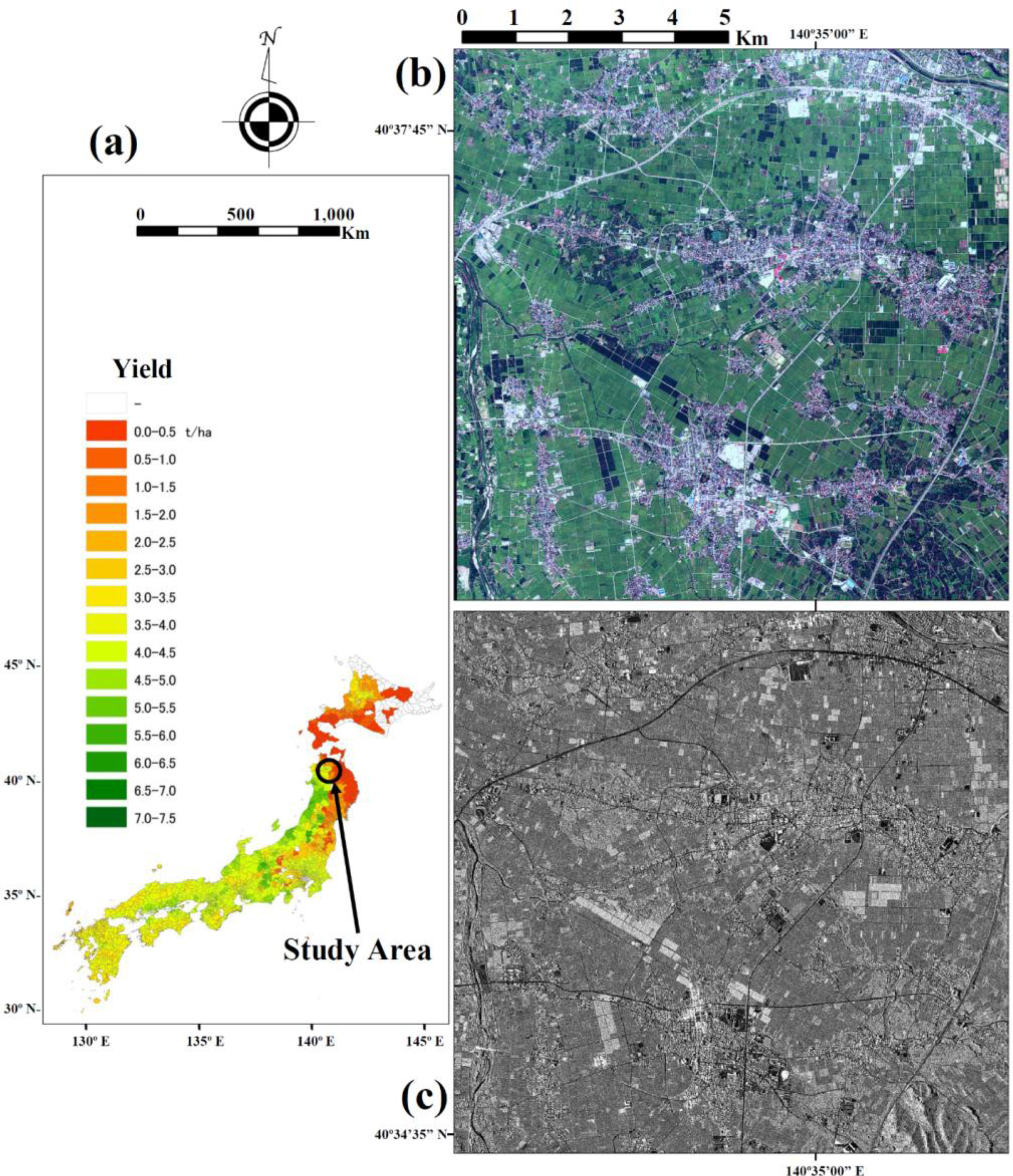
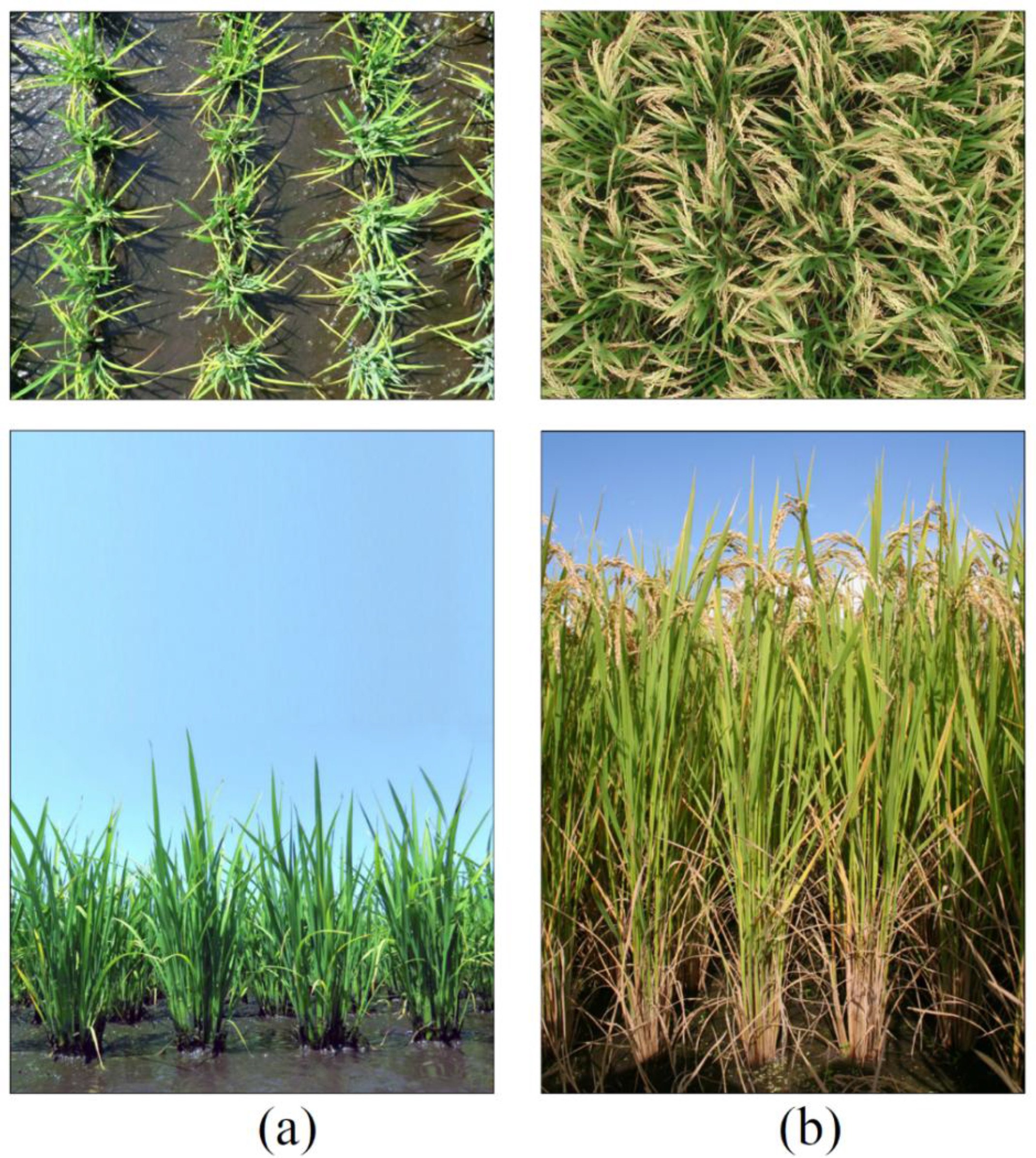
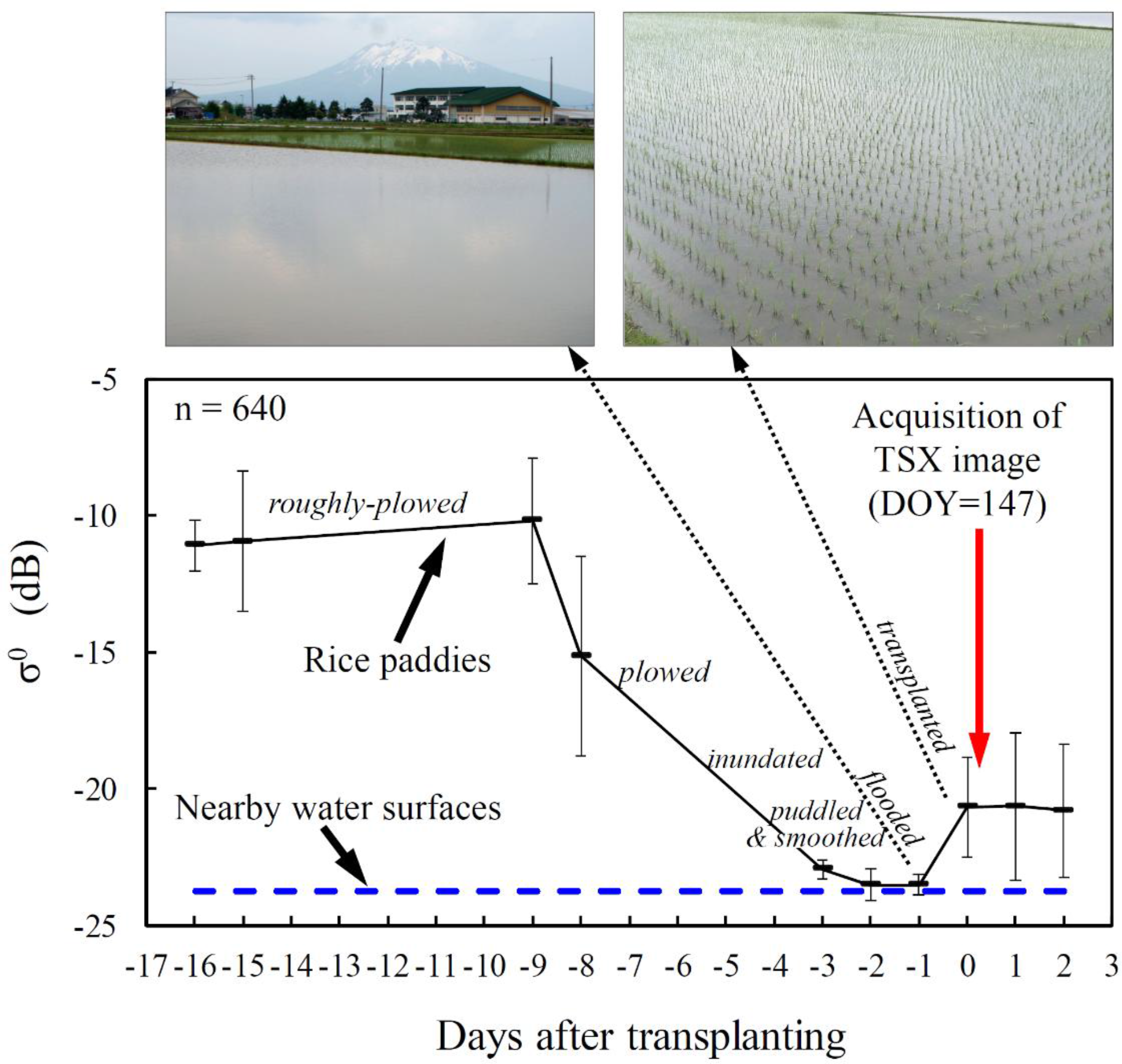

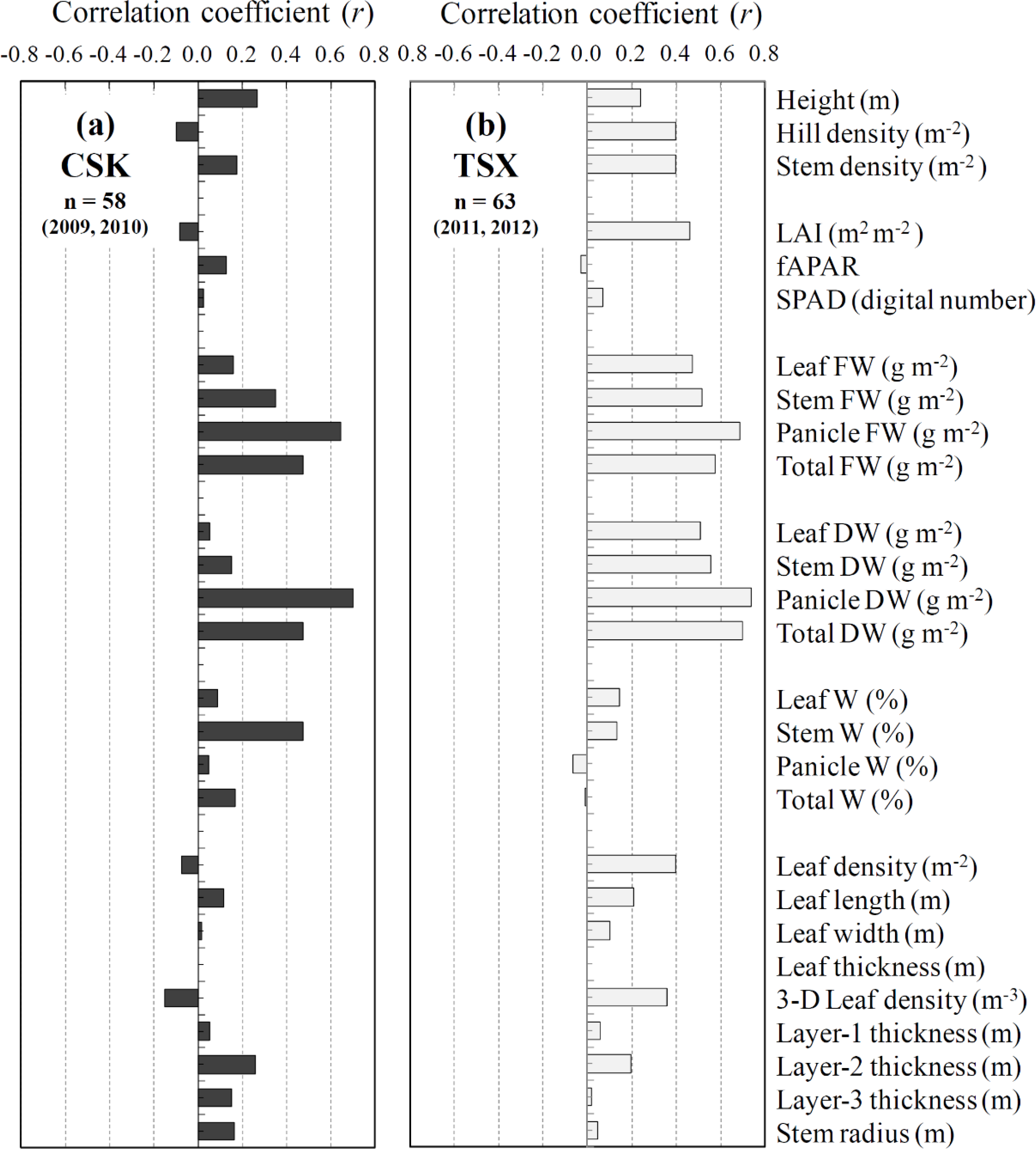
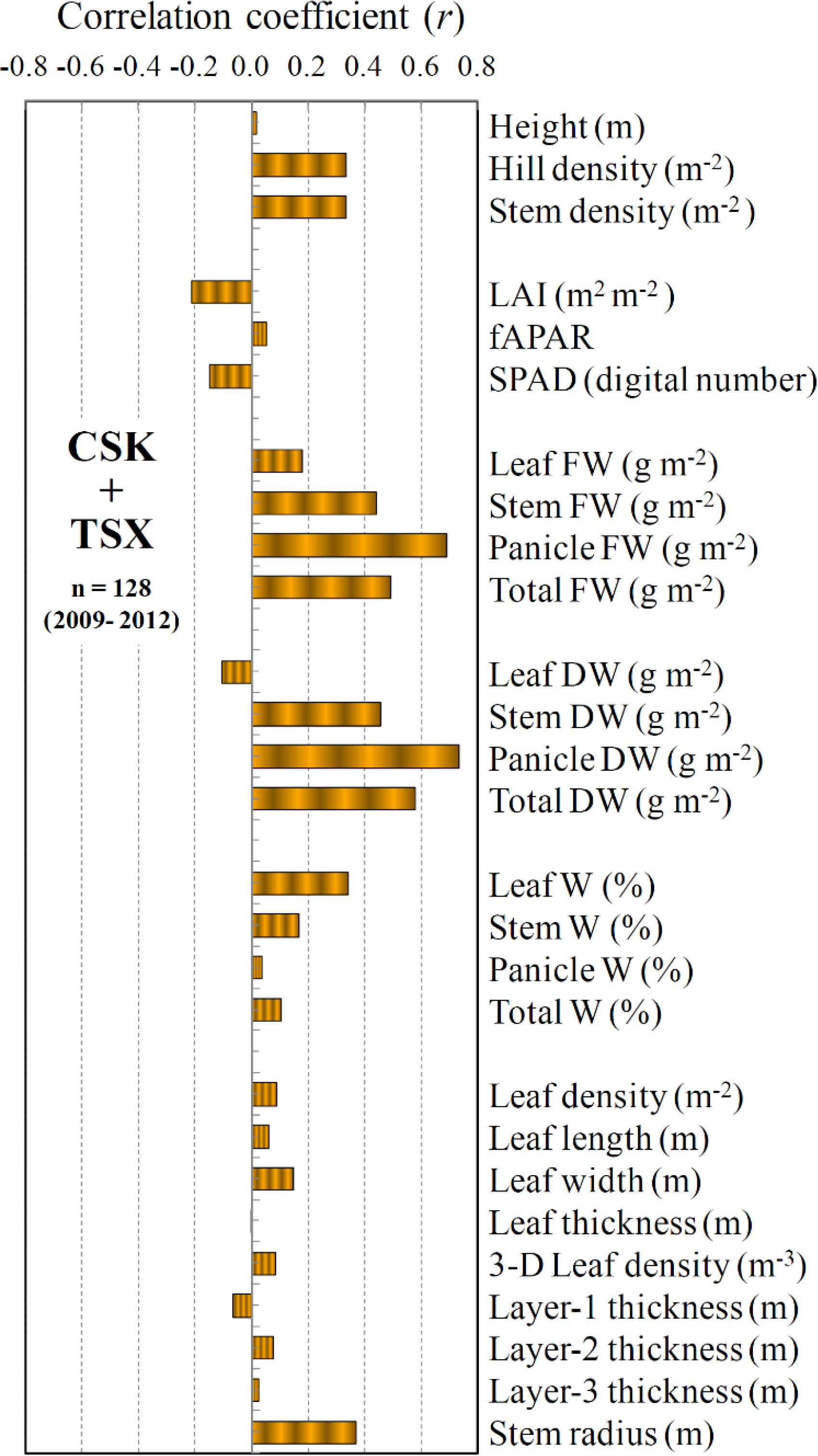

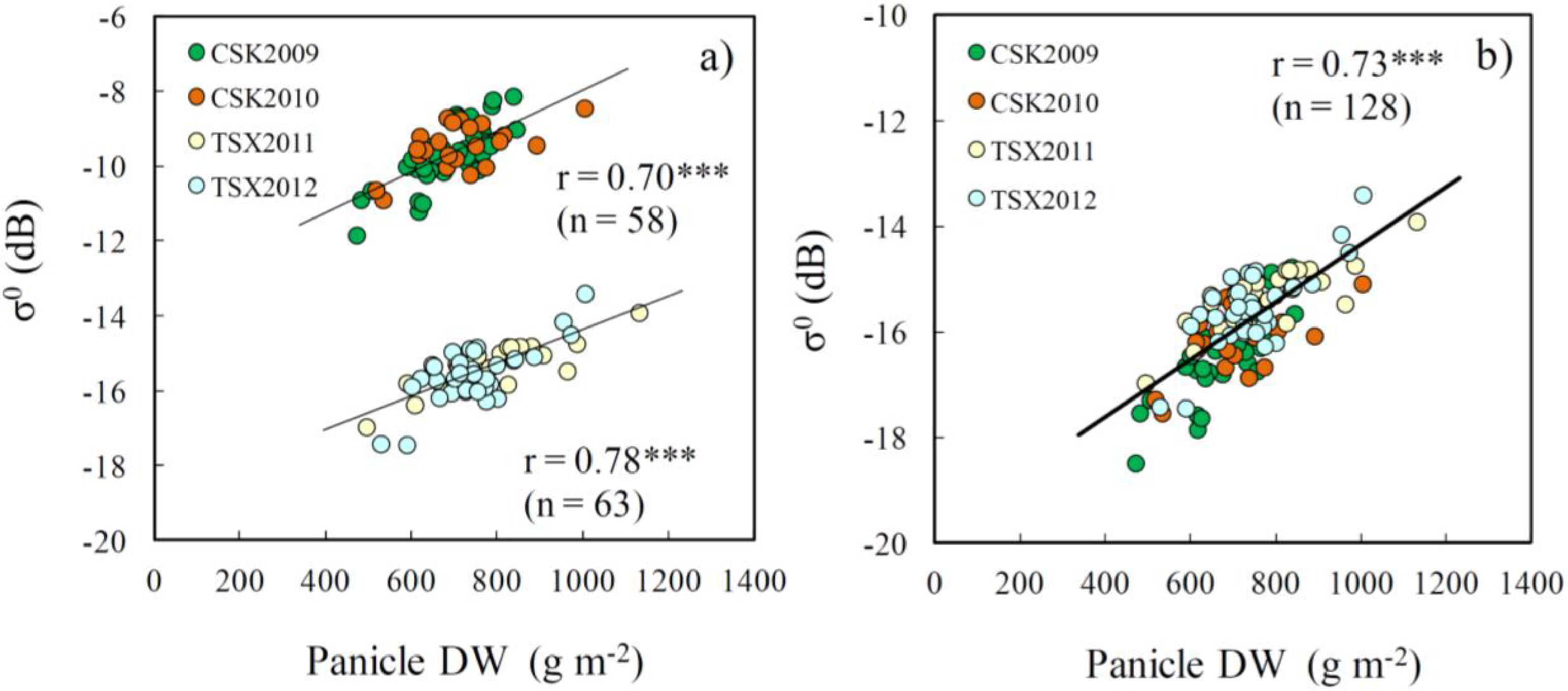
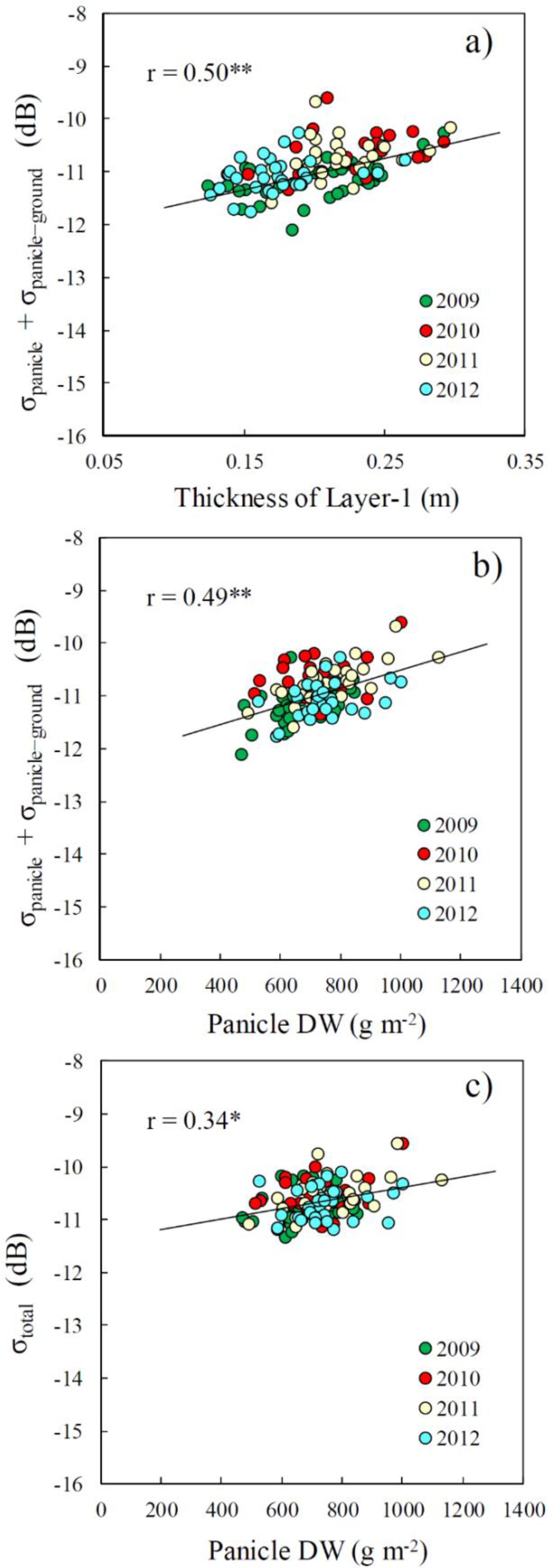
| Sensor | Mode | Pass | Date (yyyymmdd) | Time LST | Incidence Angle (°) | Polarization | Growth Stage | Range of Major Biophysical Variables in Observed Fields | |||
|---|---|---|---|---|---|---|---|---|---|---|---|
| Height (m) | Stem Dens. (m−2) | Biomass (kgDW m−2) | |||||||||
| 1 | CSK | Spotlight | D | 20090905 | 17:29 | 54 | VV | Maturity | 0.83–1.15 | 290–516 | 1.00–1.70 |
| 2 | CSK | Spotlight | D | 20100908 | 17:33 | 54 | VV | Maturity | 0.99–1.16 | 273–564 | 0.87–1.88 |
| 3 | TSX | Spotlight | A | 20110906 | 17:30 | 50 | VV | Maturity | 0.88–1.12 | 285–501 | 1.05–2.13 |
| 4 | TSX | Spotlight | A | 20120903 | 17:30 | 50 | VV | Maturity | 0.87–1.15 | 284–658 | 1.06–1.83 |
| 5 | TSX | Spotlight | D | 20120526 | 5:42 | 44 | VV | Trans-planting | 0–0.15 | 0–285 | 0–0.005 |
© 2014 by the authors; licensee MDPI, Basel, Switzerland This article is an open access article distributed under the terms and conditions of the Creative Commons Attribution license (http://creativecommons.org/licenses/by/3.0/).
Share and Cite
Inoue, Y.; Sakaiya, E.; Wang, C. Potential of X-Band Images from High-Resolution Satellite SAR Sensors to Assess Growth and Yield in Paddy Rice. Remote Sens. 2014, 6, 5995-6019. https://doi.org/10.3390/rs6075995
Inoue Y, Sakaiya E, Wang C. Potential of X-Band Images from High-Resolution Satellite SAR Sensors to Assess Growth and Yield in Paddy Rice. Remote Sensing. 2014; 6(7):5995-6019. https://doi.org/10.3390/rs6075995
Chicago/Turabian StyleInoue, Yoshio, Eiji Sakaiya, and Cuizhen Wang. 2014. "Potential of X-Band Images from High-Resolution Satellite SAR Sensors to Assess Growth and Yield in Paddy Rice" Remote Sensing 6, no. 7: 5995-6019. https://doi.org/10.3390/rs6075995




